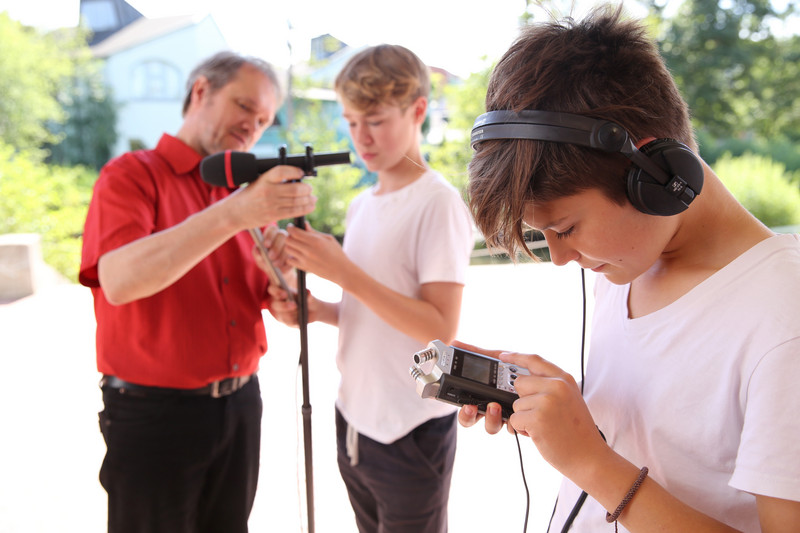Becoming media-savy – with and without a Video Screen: Initial Results of an Alanus Study on Media Instruction in Progressive Education

Education in the digital age has not only been an important issue since the coronavirus pandemic and the home and online teaching associated with it. For years there has been a somewhat heated discussion of whether digitalisation in German classrooms makes sense or is nonsense. What is interesting in this context is the concept of media maturity; the idea behind this is to familiarise children and young people with different media appropriate to their age, so they will be able to deal with it autonomously later on. The four-year research project Media instruction at progressive educational facilities by Paula Bleckmann, professor at the Institute of Media Education at the Alanus University in Alfter near Bonn, makes a major contribution to the scientific examination of the issues involved.
Extensive Training in Media Skills
Many educationally progressive kindergartens and schools deliberately reject media on video screens in early and middle childhood. For example, when pupils produce a flip book or a radio play themselves, they learn about the character of these media in very practical terms. When they follow the arrows in a sorting network in the schoolyard, they understand the basics of information processing systems in a playful way. We use sorting algorithms unconsciously in any online search. But do we also understand how they work?
In principle, understanding and shaping have a higher priority in progressive educational media instruction than operating and consuming. Until now, these programmes have not been put into practice across the board. Which is why examples of good practice have been collected at the first stage of the research project. They are to be further developed and disseminated as assistance for responsible and sustainable media education. In the follow-up project, Analogue digidactics – practical examples of how children get fit for a digital age without a video screen, a manual and website are being created. “This ambitious research project confronts digitalisation in the classroom that is less well-founded in terms of content and occurs increasingly earlier with programmes that are meaningful and justified in terms of understanding human beings”, says the educationalist and SAGST project manager Prof Dirk Randoll with conviction. “Not least, it is also a question of models of alternative media education being acknowledged and taken seriously in both the academic debate as well as in digital education policy.”
MünDig Study Interim Report
A second building block of the project is the MünDig study, an online survey of the issue of maturity and digitalisation, in which around 1,400 educational professionals, 3,000 parents and 500 pupils of progressive educational institutions took part in 2019. In an interim report at the end of 2020, the research team was already able to reveal insights into the results of the parent survey. Accordingly, Montessori and Waldorf parents rate the practice at their children’s educational facilities positively overall. An average of 90 per cent were satisfied with the part of the media education that does without tablets, computers, etc.
However, many parents would like more educational and technical support from the teaching staff, such as with the installation of time-limiting or filtering software. Depending on the children’s age, there were also significant differences, especially when asked how parents rate the use of video screen media. While most parents of kindergarten and elementary school children think it is good that computers are still ignored in these age groups, the parents of children in years 7 to 13 would like the potential of digital devices to be used more effectively in classrooms. More than half (56 per cent) are very or rather dissatisfied in this respect. This group is also more critical when it comes to producing and presenting with media: 39 per cent of the parents of sixth formers in the survey are of the opinion that video screen media are not used enough in this regard.
In the third section, training and further education, the team is working on the final draft of the media maturity certificate course. This is based on the ECHT DABEI prevention programme co-designed by Paula Bleckmann and it begins at the Alanus University in cooperation with other venues in the autumn of 2021. It will comprise face-to-face and online modules and is aimed at educationalists at state and progressive educational institutions. The focus here is on the age group from nought to 12. For older target groups, Waldorf educational practice material will be created at the Free University of Stuttgart and training and educational courses on the subject provided.
Event note: Media maturity – growing up healthy and gaining digital skills Symposium on 4 March 2021
The coronavirus pandemic requires new forms of teaching – the possibilities and risks of digitalisation are becoming more apparent as if under a magnifying glass. At the online Symposium of ECHT DABEI, representatives of the health and education system, politics, science and educational practice get together.
For more information about the programme and to register:
https://www.echt-dabei.de
More about this subject:
Growing up healthy with the media was also the annual theme of SAGST’s magazine in 2019. The project website provides insights into some exciting projects about the subject, which pupils from Düsseldorf and Mönchengladbach designed for the foundation in 2019.
You can also find tips for dealing with the media during the coronavirus era in this article, which appeared on the SAGST website in May 2020.
